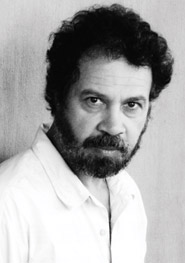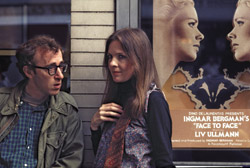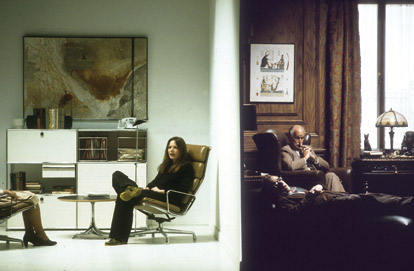BY F.X. FEENEY
 INSPIRATION: Ed Zwick says Allen broke
INSPIRATION: Ed Zwick says Allen broke
down all
kinds of barriers for American
comedy
with Annie Hall.
Over the past three decades it has grown easy to take
Annie Hall for granted as Woody Allen's warmest and sweetest film. But watch it with Ed Zwick, and you discover a veritable
Citizen Kane of romantic comedy.
"What Woody did," states Zwick, as we sit down to watch the film again in his Santa Monica office, "was break through every shackle, every convention that had inhibited American filmmakers for so long. He combined aspects of his own comedy, sketch comedy and stand-up comedy with his love for the history of movies."
Zwick's fondness for Annie Hall dates back to the early '70s when he became friendly with the director while Allen was making Love and Death. Zwick says the director gave him a copy of Anhedonia—the 200-page screenplay that eventually became Annie Hall. "It was as non-linear as the finished film—more so. I felt I was present at the revolution."
The version of Annie Hall in our memory scans like simplicity itself. A lively 1970s love affair with its beginning and passion; the family tensions and backgrounds driving the two lovers; the end of the romance and a painful breakup; and what both characters finally embrace—an abiding friendship. But seeing it with Zwick, what comes to life is the film's extraordinary—and surprisingly complex—structure.
After a silent credit sequence as chastely lettered as any of Ingmar Bergman's, Allen, as comedian Alvy Singer, talks straight into the camera, quoting Groucho Marx. "I don't think anybody had ever spoken straight to the camera in an American film before," says Zwick. "I think what he intuitively understood was that such a freewheeling approach in no way hurt the forward motion of the story."
Memories of 1940s Brooklyn mix at high speed with Alvy's "stand-up" narration. We glimpse him living with his boisterous family under the roller coaster in Coney Island; complaining to the family doctor that the universe 'will break apart.' As young Alvy scampers alongside a busty blonde, Zwick chuckles. "That shot is literally out of Fellini. Even the music is a Nino Rota theme."
 ODD COUPLE: Allen managed to film falling in love by turning the camera
ODD COUPLE: Allen managed to film falling in love by turning the camera
into a vessel to look inside. But Alvy and Annie's different backgrounds
are what attracts them and drives them apart.A very Wellesian memory shot follows, in which the camera tracks past a long chalkboard behind a row of grimly remembered schoolteachers: "See? He creates an entire environment," says Zwick, as the camera floats by that grotesque rogues gallery, "but not by building a set. He implies one instead by building a single shot."
This brings us to the film's first hilarious shock: Alvy doesn't just remember his old teachers, he enters his own flashback as an adult. What's more, his 6-year-old former schoolmates each has a jaded awareness of precisely where they will be in 30 years—one will be a heroin addict, another a cross-dresser. Zwick notes: "This very daring talk about sexuality sets us up for a comedy about the dynamics of a real relationship."
When a clip breaks in from an actual appearance Allen made on The Dick Cavett Show in 1971, Zwick pauses to reflect on how the director is playing with his own mythology throughout the film. The Cavett clip lends a documentary touch to all the proceedings, Zwick explains, "signposting 'this is a true story,' openly trading on our knowledge of Woody Allen to create Alvy Singer."
Back in the present, Alvy and his best friend (Tony Roberts) are walking on the street in rapt conversation, approaching the camera from a great distance. At first they are not even visible. The visual intelligence that has become a trademark of Allen's later films enters his work here for the first time, highlighted by the unorthodox composition. "Here we have this deep, long master shot," observes Zwick. "Almost perversely static and empty—they're not even in frame yet. We're not watching so much as listening. The idea is that it's really happening; life is happening in that frame."
Zwick suggests casting cinematographer Gordon Willis behind the camera was as essential to the life of this film as putting Diane Keaton in front of it. "Gordy understood Woody's emphasis on the word, and thus was instrumental in creating the tableau, the technique, that later became so institutionalized in Woody's movies. The very idea of having someone leave the frame, yet keep talking, sometimes leaving behind an empty frame, was unheard of in American film. It forces you to lean forward, to listen, so that the verbal virtuosity becomes central."
Annie (Keaton) is introduced not as their affair is beginning, but as it enters its death throes. Late to meet Alvy for a movie, they start arguing the instant she emerges from a cab. Alvy and Annie continue fighting in line as a loudmouth pompously holds forth to his date about Marshall McLuhan until Alvy confronts him with the actual McLuhan, magically standing in the wings. Delighting in the anarchy of this exchange, Zwick nevertheless points to the camerawork; how the whole scene unfolds in a single, two minute, complex master, without cuts. "No coverage. No breakdown," marvels Zwick. "All happening in that two-shot, in the classic manner of the Howard Hawks comedies, the Capra comedies."
As a director who knows the pressures of making his shooting day, Zwick points out that there is a practical as well as an aesthetic value at work here: "How do you shoot eight pages a day when you need to? How do you set up a shot so that you actually eat up that page count and still make it visually arresting? There is style here, but it's also problem solving."
 After 30 minutes, the film doubles back to
After 30 minutes, the film doubles back to
show their first meeting.

The couple has trouble in bed.

Annie is backed by a poster for Bergman's
Face to Face.
The scene jumps from Alvy and Annie and their problems in bed to a tour of Alvy's first two failed marriages where sex was a problem, too. Observing closely, Zwick points out a wide variety of subtle repetitions—in furniture, in posture, in blocking patterns. "He's visually setting up the pattern of disaffection," he says. "The lamps and beds are similar, as are the rooms, probably a single set dressed different ways," but the boards containing books sprout into cheap shelves and then expensive shelves, "all worked out with great care to suit Alvy's changing economic status as he finds greater success as a comedian."
When Alvy meets his first wife Allison (Carol Kane) backstage at a political rally, Zwick particularly admires how she is shot. "See how everybody else is color-timed to be cold? Kane has never been more beautifully photographed. Her face is softly cut by that warm, diffuse light in the foreground; she's glowing."
A scene or so later—the film's chronology all but dancing now—Alvy and Annie crack up as they summon the courage to toss a bunch of roaming lobsters into a boiling pot of water. "This is the first instance of a camera being handheld," says Zwick. It's literally just one shot—all handheld—letting them improvise and create. It captures this feeling of being free and impulsive and spontaneous."
Zwick excitedly points out the great structural surprise of Annie Hall, which you hardly notice unless you're watching the film as closely as he is: It's 30 minutes into the movie before it doubles back to that once-upon-a-time moment when Alvy first meets Annie at the tennis court. Zwick thinks this is a remarkable choice. "We never remember it that way, we never remember it properly, until we see the beginning again, and then we say, 'Oh, God, he set the table.'"
Sporting her cute derby and vest, Annie is warmly and luminously tongue-tied as she flirts with Alvy. The camera fixes its gaze upon her. "Woody has managed here to film falling in love," says Zwick. "He's facing something, reliving something true, and suddenly the camera, which is ordinarily so clinical, becomes this object, this vessel, this means of looking inside."
To show that their love has blossomed, Allen stages several walks at sunset, but they are not the conventional romantic devices we are used to seeing. In one of the walks Alvy and Annie move out of frame, and in another they are entirely absent from the frame altogether. According to Zwick, each of these setups required daring and timing. "Woody and Gordy had to be shooting right up against the edge of losing light," says Zwick. "Six seconds later, and that shot is gone."
This brings to mind some advice—actually, a prediction—Allen offered Zwick when he was first starting out as a director. "Something doesn't go quite right in a shot on Tuesday morning, Woody told me, and you say, 'We gotta move on, we're behind.' And then Wednesday evening you're losing the light, and you've got to cut a shot or you've got to rush something. And that's inevitable—you have to make these compromises. But even if you only compromised an average of three times in a five-day week, after twelve weeks that means there are thirty-six moments when you sit down to put it together, where you are cringing." Zwick laughs, stoic at how prophetic these words have proved. "And I think that's one reason directors go mad, because every shot, every shot, is opening night."
Zwick turns his attention back to the film as Annie takes Alvy home to Chippewa Falls to meet her parents. He sees the tension between the characters as "a cultural exploration and very much at the heart of the affair." Annie's grandmother, Grammy Hall, is a virulent anti-Semite, and in a sight gag that is both amusing and purposeful, Alvy imagines her seeing him as a Hasidic Jew in a black coat and long beard. "His being a New York Jew and Annie being a Midwestern Gentile is what attracts them and drives them apart. But he's also making that neurotic Jewish character into a romantic hero. Notice he's discovered Ralph Lauren. He's got this very casual yet very stylish thing going on there, with that tattersall shirt and sport coat. He's reinventing the Jewish comic as a sexy male archetype." This was enormously influential, says Zwick, and "relevant to many films and even more television that came after," including his own shows thirtysomething and My So-Called Life (co-created with Marshall Herskovitz).
Zwick delights in Allen's inventive use of the split-screen as a comic but telling device. At the dinner table Annie's mother reaches across time and space from the Midwest to Alvy's long-ago mother in Coney Island. Similarly, Alvy and Annie complain about one another to their respective analysts—voicing the same complaints, but with different emphasis.
Zwick zeroes in on the point at which their affair starts to go sour as Annie herself splits in two. There is her physical self, in bed, making love to Alvy (or trying to) and her spirit self, who has a seat by the window. "Freud said when two people get into bed together, at least eight people are invisibly in there with them," declares Zwick. "Freud may have said it, but Woody showed it. And that is the bravery of the film."
Keaton sings twice in the film. The first performance takes place in a second-rate venue, where loud chairs are heard scraping, and people keep their backs to her. The second time, "she's polished now, confident," notes Zwick. There is no extraneous noise, the audience is focused, and Keaton, elegant in a man's tux, has bloomed with Alvy's encouragement. The frame is dark with Keaton over to one side and three vertical lights at her back. "They're using a real location, and the club is simply lit that way," observes Zwick. "Notice on the cutaway that the vertical lights are all around, and actually close together. To get that elegant composition, Willis might have just had them kill one row."
 MIRROR IMAGE: In split-screen, Alvy and Annie complain about one another to their analysts.
MIRROR IMAGE: In split-screen, Alvy and Annie complain about one another to their analysts.
The original surprise of these scenes in 1977 was the delicate beauty of Keaton's singing voice. "There's a history of directors for whom an actress becomes a muse, a creative partner," says Zwick, watching Keaton warble "Seems Like Old Times." Woody had a privileged view [of Keaton], and he used what he saw to honor something that seemed a revelation to everyone but him. Artists are opportunistic."
The story moves to California, and Allen's collaboration with Willis takes an appropriately hilarious turn to signal the shift. Light blasts the eye as Allen, Keaton and Roberts, obscured by the terrible glare, drive beneath tall palm trees. "Gordy must have opened it up two stops," laughs Zwick. "And it's clear he chose not to use a polarizing filter, so instead of seeing their faces we play the reflections instead."
Although the end of Alvy and Annie's romance is sad, Zwick notes how Allen presents it with impeccable comic timing. Alvy attempts one doomed effort at rescuing the affair, meeting Annie at a health food restaurant (the old Source on Sunset Blvd.). He orders a plate of mashed yeast, only to be told that she has found happiness with someone else. Grieving at her refusal, he accidentally takes his frustrations out on the other cars in the parking lot—with a quick cutaway to the Coney Island bumper cars of his childhood—until a motorcycle cop speeds into the frame with the smoothness of a punchline. "All one shot, no cuts," Zwick says, "and look how perfectly that cop's entrance is timed. One missed cue and the whole scene fails."
The seeming climax of the movie—Alvy's doomed marriage proposal—is likewise repeated, with a funny, deliberate clumsiness, in a play about himself and Annie that Alvy is rehearsing, as the film ends. "This is the actual climax of the film," Zwick suggests. "He's not just being cleverly self-referential here; he's questioning his own enterprise. Can one really do honor, do justice, to the feelings of one's life in a movie? By dramatizing his own dissatisfaction, he is asking us to share his deepest realization—that the past is past, and its power and feeling can never be adequately evoked. This redounds to something very emotional, and very meaningful for me."
Zwick proclaims his loyalty to the vision of cinema Allen practiced in Annie Hall in 1977, and embraces its influence to this day. "Ideas in movies had a currency that were the rival of explosions, the rival of effects, the rival of scale. That an idea could be commercial—that an idea could be profitable—that was enough to inform a great movie experience."